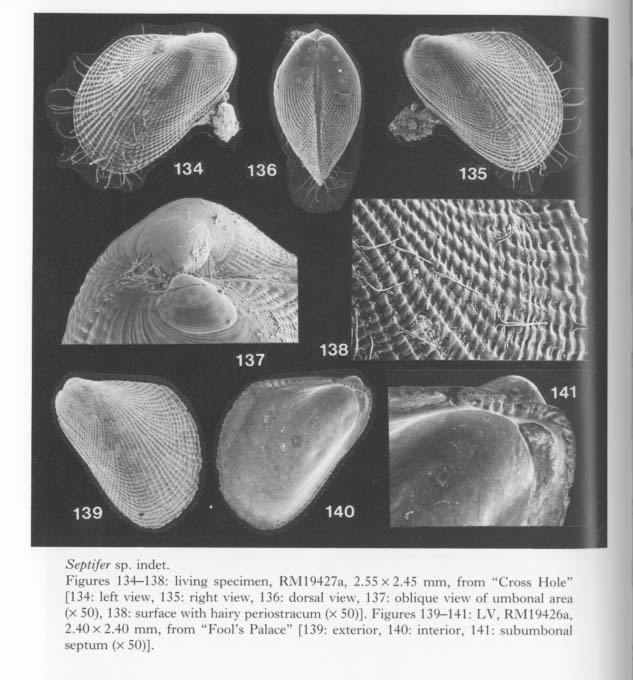Genus Septifer Recluz, 1848
Septifer sp. indet.
Figures 134-141

Diminutive specimens of Septifer occur, though rarely, in the bottom sediments of "Fool's Palace" (RM19426), "Wall Cave" (RM19589, partly living) of Shimoji Islet and "Cross Hole" (RM19427, partly living) of Irabu Islet, Miyako Islands.
The shell is generally smaller than 3 mm in length and height, trigonally ovate, greenish when alive, and characterized by sparsely distributed bristles of periostracum, non-terminal umbo, many small denticles along the hinge line, crenu-lated inner margin, luniform subumbonal septum, and finely cancellate sculpture which consists of divaricate ribs and commarginal lamellae of similar strength. The Pd I is about 80 µm, and the veliconch (Pd I + Pd II) is about 390 µm in maximum diameter.
In view of the greenish coloration and hairy periostracum, we at first imagined that these specimens represent juveniles of Septifer bilocularis (Linnaeus, 1758) or Septif er excisus (Wiegmann, 1837), which are commonly distributed in rocky shores of this region. The triangular shell and shape of the subumbonal septum, however, are rather similar to those of a common Japanese species, Septifer keenae Nomura, 1936 [justified emendation by Habe (1951) for Septifer keeni, in accordance with ICZN Art. 32c], although the periostracum is black and not hairy in that species.
Unlike the above-mentioned species of Septifer, living individuals of the present species were found attached by byssus to small lumps of sediments on the soft bottom of the caves (Figures 134, 135). Because of its rare occurrence, it is not known whether the present species is indigenous to the cryptic environments or not.
According to our preliminary observation, the present species also occurs in "Balicasag Cave" off Panglao Islet of Bohol Island, the Philippines and "Chandelier Cave" near Koror, Palau Island.